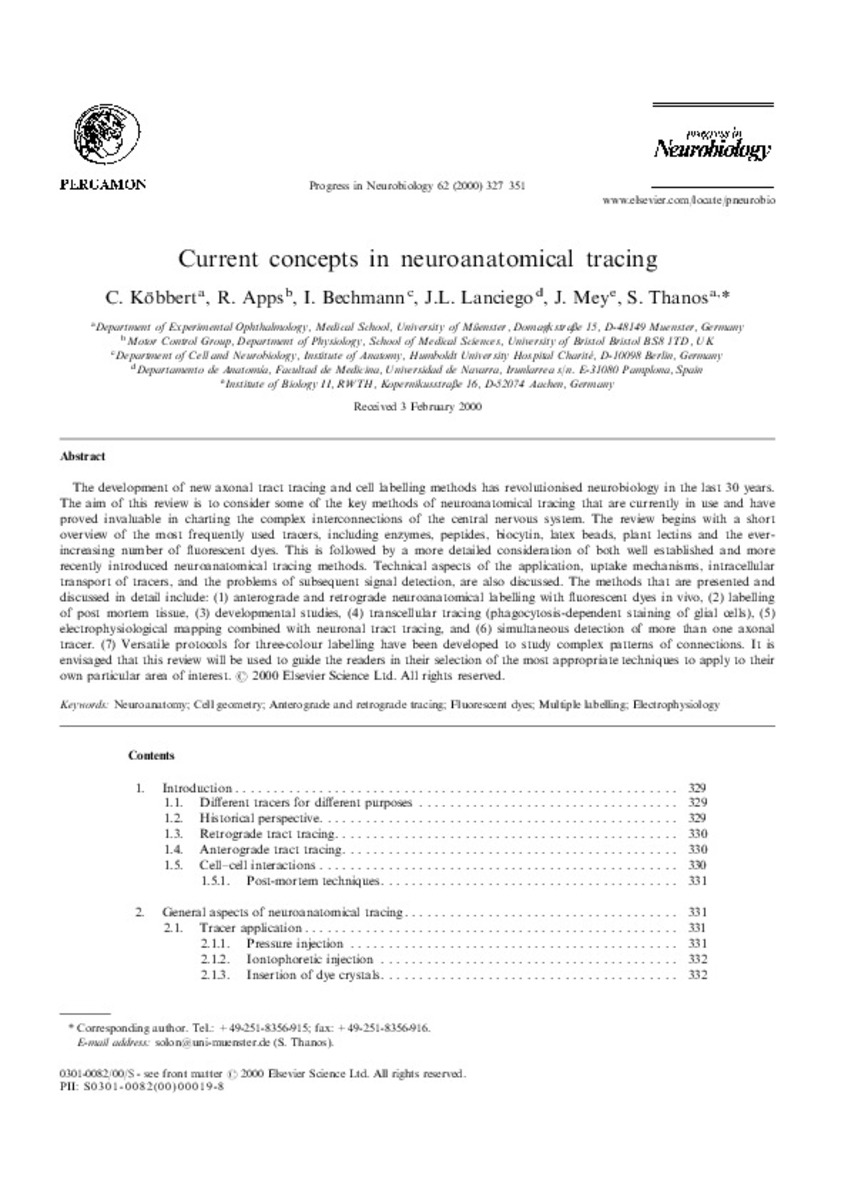Full metadata record
| DC Field | Value | Language |
|---|---|---|
| dc.creator | Köbbert, C. (C.) | |
| dc.creator | Apps, R. (R.) | |
| dc.creator | Bechmann, I. (I.) | |
| dc.creator | Lanciego, J.L. (José Luis) | |
| dc.creator | Mey, J. (J.) | |
| dc.creator | Thanos, S. (S.) | |
| dc.date.accessioned | 2011-12-05T08:11:29Z | - |
| dc.date.available | 2011-12-05T08:11:29Z | - |
| dc.date.issued | 2000 | - |
| dc.identifier.citation | Kobbert C, Apps R, Bechmann I, Lanciego JL, Mey J, Thanos S. Current concepts in neuroanatomical tracing. Prog Neurobiol 2000 Nov;62(4):327-351. | es_ES |
| dc.identifier.issn | 1873-5118 | - |
| dc.identifier.uri | https://hdl.handle.net/10171/20115 | - |
| dc.description.abstract | The development of new axonal tract tracing and cell labelling methods has revolutionised neurobiology in the last 30 years. The aim of this review is to consider some of the key methods of neuroanatomical tracing that are currently in use and have proved invaluable in charting the complex interconnections of the central nervous system. The review begins with a short overview of the most frequently used tracers, including enzymes, peptides, biocytin, latex beads, plant lectins and the ever-increasing number of fluorescent dyes. This is followed by a more detailed consideration of both well established and more recently introduced neuroanatomical tracing methods. Technical aspects of the application, uptake mechanisms, intracellular transport of tracers, and the problems of subsequent signal detection, are also discussed. The methods that are presented and discussed in detail include: (1) anterograde and retrograde neuroanatomical labelling with fluorescent dyes in vivo, (2) labelling of post mortem tissue, (3) developmental studies, (4) transcellular tracing (phagocytosis-dependent staining of glial cells), (5) electrophysiological mapping combined with neuronal tract tracing, and (6) simultaneous detection of more than one axonal tracer. (7) Versatile protocols for three-colour labelling have been developed to study complex patterns of connections. It is envisaged that this review will be used to guide the readers in their selection of the most appropriate techniques to apply to their own particular area of interest. | es_ES |
| dc.language.iso | eng | es_ES |
| dc.publisher | Elsevier | es_ES |
| dc.rights | info:eu-repo/semantics/openAccess | es_ES |
| dc.subject | Neuroanatomy | es_ES |
| dc.subject | Cell geometry | es_ES |
| dc.subject | Anterograde and retrograde tracing | es_ES |
| dc.subject | Fluorescent dyes | es_ES |
| dc.subject | Multiple labelling | es_ES |
| dc.subject | Electrophysiology | es_ES |
| dc.title | Current concepts in neuroanatomical tracing | es_ES |
| dc.type | info:eu-repo/semantics/article | es_ES |
| dc.relation.publisherversion | http://www.sciencedirect.com/science/article/pii/S0301008200000198 | es_ES |
Files in This Item:
Statistics and impact
Items in Dadun are protected by copyright, with all rights reserved, unless otherwise indicated.






